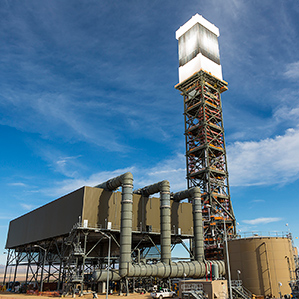Solar Thermal Technology Poses Challenges for Drought-Stricken California
California’s ambitious goal of getting a third of its electricity from renewable energy sources by 2030 is being tested by its driest year on record, part of a multiyear drought that’s seriously straining water supplies. The state plan relies heavily on solar thermal technology, but this type of solar power also typically consumes huge quantities of water.

The drought is already forcing solar thermal power plant developers to use alternative cooling approaches to reduce water consumption. This will both raise costs and decrease electricity production, especially in the summer months when demand for electricity is high. Several research groups across the country are developing ways to reduce those costs and avoid reductions in power output.
Solar thermal power plants use large fields of mirrors to concentrate sunlight and heat water, producing steam that spins power-plant turbines. Utilities like them because their power output is much less variable than power from banks of solar panels (see “BrightSource Pushes Ahead on Another Massive Solar Thermal Plant” and “Sharper Computer Models Clear the Way for More Wind Power”).
The drawbacks are that solar thermal plants generate large amounts of waste heat, and they consume a lot of water for cooling, which is usually done by evaporating water. Solar thermal plants can consume twice as much water as fossil fuel power plants, and one recently proposed solar thermal project would have consumed about 500 million gallons of water a year.
A technology called dry cooling, which has started appearing in power plants in the last 10 years or so, can cut that water consumption by 90 percent. Instead of evaporating water to cool the plant, the technology keeps the water contained in a closed system. As it cools the power plant, the water heats up and is then circulated through huge, eight-story cooling towers that work much like the radiator in a car.
Dry cooling technology costs from two and a half to five times more than conventional evaporative cooling systems. And it doesn’t work well on hot days, sometimes forcing power plant operators to cut back on power production. In the summer, this can decrease power production by 10 to 15 percent, says Jessica Shi, a technical program manager at the Electric Power Research Institute. On extremely hot days, power production might be reduced even more than that.
One approach to solving this problem is to oversize the cooling system so that it can deliver enough cooling even on hot days. That’s the approach taken by the developers of California’s new Ivanpah solar thermal plant, which is about to start production (see “World’s Largest Solar Thermal Power Plant Delivers Power for the First Time”). But it adds to the cost of an already expensive system.
More than a dozen research groups funded by the Electric Power Research Institute and the National Science Foundation are developing ways to avoid the current problems with dry cooling technology. One project uses a conventional evaporative cooling system but captures the water vapor to reuse it. Others are working to improve the efficiency of dry cooling towers so that they can be made smaller and cheaper. A third approach is to use nanoparticles in the cooling fluid to improve its ability to absorb heat. And new designs that improve air circulation could reduce the size and cost of cooling towers.
The drought and water shortage that California is undergoing will increase the costs associated with solar thermal power, but they aren’t likely to bring the spread of the technology screeching to a halt. While dry cooling costs far more than conventional water cooling, it accounts for a relatively small part of the total cost of a plant—about five percent of around $2 billion.
Keep Reading
Most Popular
Large language models can do jaw-dropping things. But nobody knows exactly why.
And that's a problem. Figuring it out is one of the biggest scientific puzzles of our time and a crucial step towards controlling more powerful future models.
The problem with plug-in hybrids? Their drivers.
Plug-in hybrids are often sold as a transition to EVs, but new data from Europe shows we’re still underestimating the emissions they produce.
Google DeepMind’s new generative model makes Super Mario–like games from scratch
Genie learns how to control games by watching hours and hours of video. It could help train next-gen robots too.
How scientists traced a mysterious covid case back to six toilets
When wastewater surveillance turns into a hunt for a single infected individual, the ethics get tricky.
Stay connected
Get the latest updates from
MIT Technology Review
Discover special offers, top stories, upcoming events, and more.